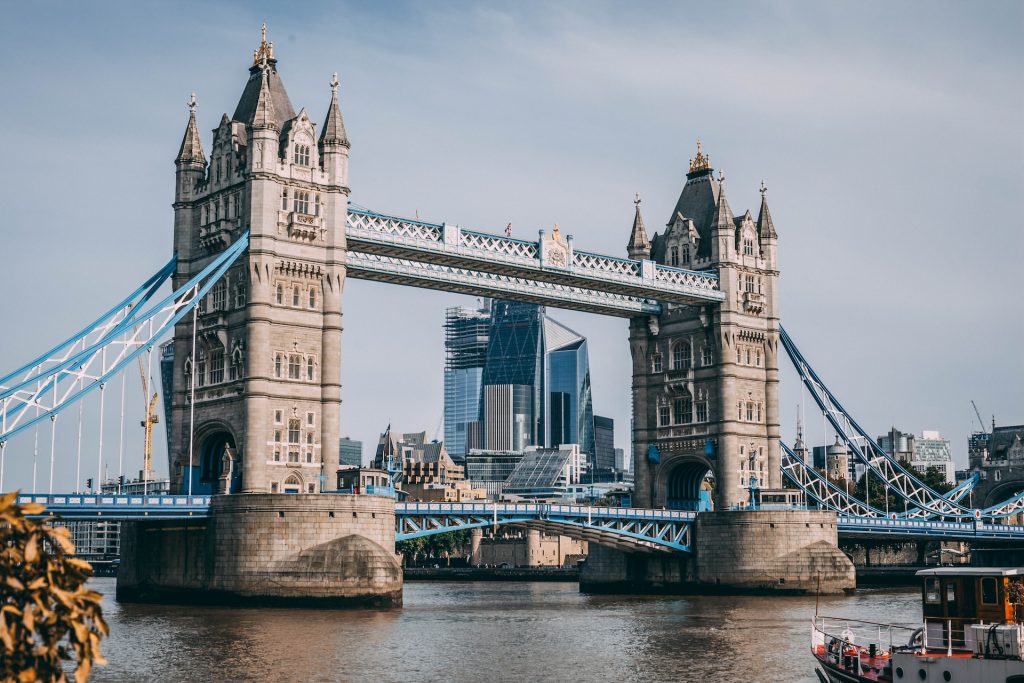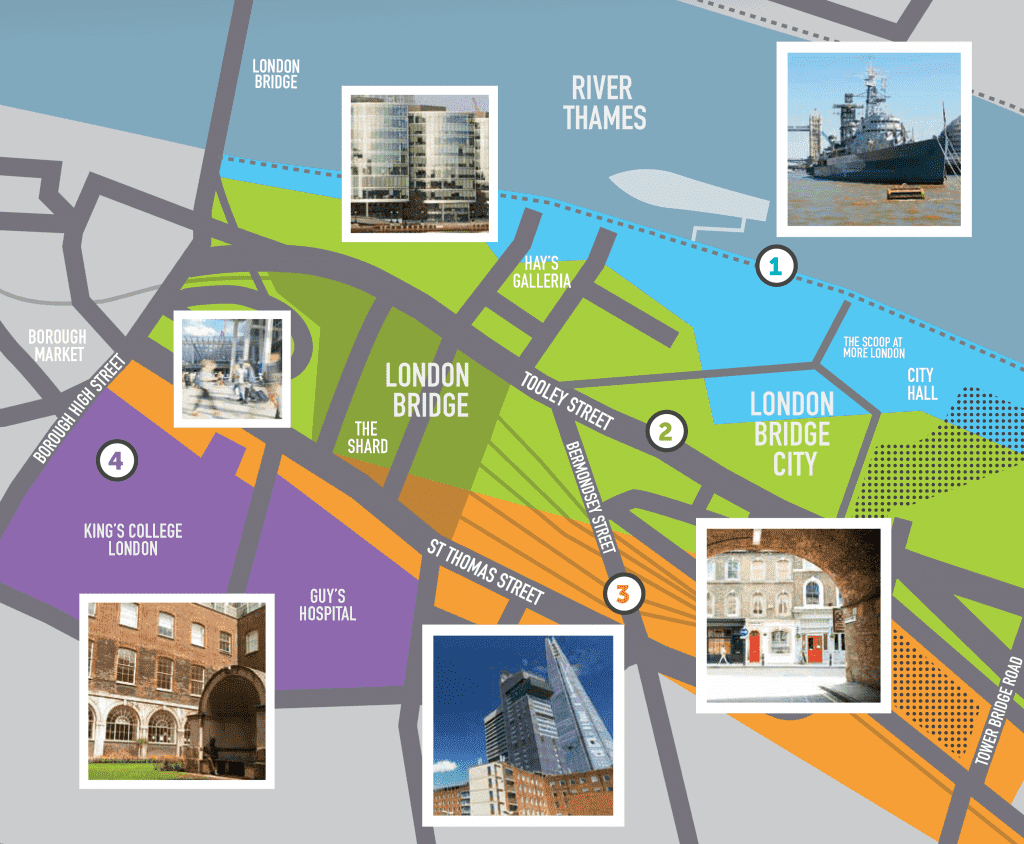London Bridge Revealed (Background)
In 2012 the London Bridge Business Improvement District (BID) challenged us to advise it on the development of a brand strategy for its area and the creation of a new brand identity.
Considered the cradle of London, the area of the BID was the location of the earliest settlement of Roman Britain in the capital and has been a key district of the city for the last Millenia. From a cultural perspective the area features in the life and works of the finest English pens like Chaucer, Shakespeare, and Dickens and, from an economic perspective, its prominence continued into the modern era when its riverfront docks played a key part in the importation of timber, furs, foodstuffs, animals, tea and other produce from the British Empire in the 19th and 20th centuries.
More recently it became a modern office hub housing the headquarters of global consulting firms, major landmark developments such as “The Shard”, a symbol of modern connectivity and global-reach, contributing to London’s image as one of the major capitals of the world.

Challenge
The approach taken by our team involved conducting “fieldwork” first to determine the perceptions of the area among people who lived in, worked in, visited or passed through it as commuters. Having surveyed these population groups and local stakeholders and major employers, the “lab work” of making sense of the data collected from them could begin.
The challenge faced by the team was to make sense of many contrasting and different perceptions of the area by the people who used it – simultaneously seen as a historic and cultural attraction and tourist destination, a commercial destination offering employment, a social gathering destination offering a range of food and beverage services, and a place of government housing the offices of the Mayor of London and the London Borough of Southwark.
A key initial finding was that many residents and recent arrivals were not fully aware of its history and many commuters had only a partial knowledge of its history and its offers, simply experiencing it just as a workplace or a place they passed through. We concluded that there was a lot more to be revealed about the area.
The challenge facing the team was to find a “Central Idea” for a Place Brand strategy for the district that captured its essence as one of the most important historic areas of the capital, a modern hub for commerce and one with a range of major tourism attractions, which could inform the marketing of its offer and its proposals for future development.
In a sense, our team was tasked with proving that London Bridge had not fallen down.
The Central Idea – London Bridge Revealed as Central London’s Most “Vibrant Place of Modern Commerce, Enterprise and Creativity”
Responding to the finding that most users of the district were unaware of its full offer, the branding strategy was named as “London Bridge Revealed” which focused on revealing the full extent of its offer – its history, its culture, its commerce and its regeneration as a modern place of creativity and business.
It was determined that the essence of the brand promise of London Bridge was to be a “globally significant, historic and vibrant place of modern commerce, enterprise and creativity”.
The core market audiences for the proposition were existing businesses, such as major international companies, major public organizations, such as the London Borough of Southwark and the Greater London Authority and their agencies, their employees, and existing residents of the area plus business and tourist visitors.
Among the existing value propositions of the district deserving a wider reveal was the new Grade A commercial office floor space. With one of Central London’s largest portfolios of new top-quality office floor space, it was an immediately attractive national and international business location for companies requiring a London-based headquarters.
This proposition was complemented by the expanding supply of e smaller commercial office and design studio spaces, resulting mainly from recent conversions and developments of historic buildings, for example on Leathermarket St, Morocco St and Bermondsey St, which housed small and medium creative, craft and design businesses, attractive to independent businesses and the booming sector of tech start-ups.
The ample stock of diversified business opportunities in the district enabled a broader channelling of media in “The Reveal “with information tailored for all the different market audiences and local stakeholders.
The Impact of the Brand Strategy and its Identity – “London Bridge Revealed”
Looking back ten years after completing the brand strategy the results display an even larger offer of opportunities and insights into the power of a Place Brand.
In the past decade not only has the business sector continued to grow so have the cultural offers and major tourist destinations attractions such as the nearby Tate Modern and the reconstructed Shakespearian Globe Theater, which, taken together, have made London Bridge into a “global destination on a small scale”.
The presence of new large businesses generated an expanded network of business support services complementing the established ones like marketing and design services, brand consultancies, product design services, office equipment and materials suppliers, recruitment agencies and software suppliers to form an attractive business destination at the heart of London.
The increased traffic of people and goods prompted the Metropolitan Police to establish the Southwark Community Security Zone, a special initiative for areas recognized as having significant political, cultural, economic and iconic status. The special attention and resources granted to the Southwark Police Department have made it one of the safest areas in the capital.
The other major feature of this “miniopolis”” at the heart of the capital centres around the cultural offer that has been a constant for centuries and continues to enlarge with new theatres and events – major private and public art galleries like “White Cube”, the London Fashion Museum”, the nearby Tate Modern Art Gallery and the Globe Theatre And the area has also significantly benefitted from the remodelled train station of London Bridge, inspired some say by New York’s Grand Central station, and the thousands of travelers it serves on a daily basis.

London Bridge continues to be a “miniopolis” inside a major metropolis with an overarching identity long confirmed among all who experience it.
“Our brand identity strategy for the London Bridge Business Improvement District was the first major brand strategy undertaken in the city center zone of London. It enabled the district to redefine its offer to a mix of existing and new audiences. It acted as a “magnet” to inform and attract new businesses, a larger workforce and a wider spectrum of visitors. In short, it has shown the “power of a Place Brand”.
Malcolm Allan, President of Bloom Consulting
* Project led by Placematters before merging with Bloom Consulting in 2018



